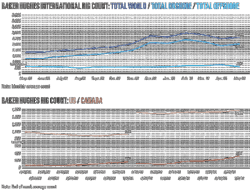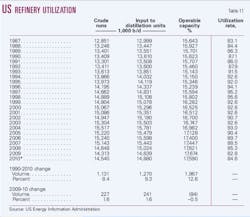Sleipner condensate is a low-sulfur North Sea condensate produced from commingling of Sleipner East, Sleipner West, and Sigyn fields. Gungne and Loke are satellite fields to Sleipner East; Alpha North is a satellite to Sleipner West. Statoil ASA operates the fields.
During recent years as a regional natural gas hub, says Statoil's web site description, Sleipner has become the second largest after Troll field and has undergone frequent upgrades, tie-ins of other fields such as Sigyn and Volve, and connection to Troll and Ormen Lange fields.
Current total production from Sleipner fields is 300,000 boe/d, 36 million cu m/day of gas, and 14,000 cu m/day of condensate. Over its lifetime, the project has produced about 1.8 billion boe.
Sleipner West
Discovered in 1974, Sleipner West lies in Norwegian North Sea Blocks 15/6 and 15/9. Production of gas and condensate (light oil) began in August 1996.
Gas is exported in Norway's transport network for sales gas, while condensate is carried by pipeline to processing at Karsto north of Stavanger. Condensate is exported from Karsto by ship.
Sleipner West is tied back to Sleipner East, and the two fields share operational organizations.
The Sleipner West development embraces the B wellhead platform on the field, and the T gas treatment installation (cover), which stands on Sleipner East and is linked by bridge to Sleipner A.
Sleipner B is unstaffed in normal operation and remotely controlled from A platform on Sleipner East. The unprocessed well stream from Sleipner B moves via pipeline 12 km to Sleipner T.
Statoil operates Sleipner West and owns 58.34% with partners ExxonMobil Norge 32.23%, and Total E&P Norge 9.41%.
Sleipner East
Sleipner East was developed with the Sleipner A drilling and production platform, linked by bridge to gas treatment and flare on platform T. Production on Sleipner East began in August 1993.
As part of the Sleipner East development, Loke and Sigyn gas and condensate satellite fields have been tied back to Sleipner A.
Condensate from Sleipner East is piped to Karsto north of Stavanger for processing.
Gas from the field is transported in Statpipe and Zeepipe to Emden, Germany, and Zeebrugge, Belgium.
Statoil operates Sleipner East and owns 59.6% with partners ExxonMobil Norge 30.4% and Total E&P Norge 10.0%.
Legend: 1ND = not detectable; NA = not analyzed due to instrumental problems; HPLC = high performance liquid chromatography; DVPE = dry vapor pressure equivalent; SD = sample too dark for measurement. 2Corrected in accordance with EN 228. 3Not possible to distinguish between 3-Methylheptane and 1,3-Dimethylcyclohexane. |
Whole crude
Density at 15° C., kg/l.: 0.7267
Specific gravity at 60/60° F.: 0.7269
API gravity at 60/60° F.: 63.2
Dry oil density at 15° C., kg/l.: 0.7267
Sulfur, mass %: 0.016
Total acid number, mg KOH/g: <0.01
Reid vapor pressure, kPa: 65.0
Pour point, °C.: <–48
Kin. vis. at 20° C., cst: 0.62
Kin. vis. at 40° C., cst: 0.52
Nitrogen, mg/kg: NA
Hydrogen sulfide, mass %: ND1
Vanadium, mg/kg: <0.1
Nickel, mg/kg: <0.1
Sodium, mg/kg: 0.7
Mercury, µg/kg: <1
Salt as NaCl, mg/l.: <5
Wax content, mass %: <5.0
Flash point, °C.: <10
Water content, mass %: <0.01
Color (ASTM): L 1.5
Pentanes to 65° C.
Yield on crude, mass %: 27.65
Yield on crude, vol %: 31.15
Density at 15° C., kg/l.: 0.6426
Specific gravity at 60/60° F.: 0.6426
API gravity at 60/60° F.: 88.7
Mercaptan sulfur, mg/kg: <3
n-Paraffins, mass %: 43.5
i-Paraffins, mass %: 50.4
Naphthenes, mass %: 4.6
Aromatics (incl. benzene), mass %: 1.6
n-Paraffins, vol %: 43.9
i-Paraffins, vol %: 51.1
Naphthenes, vol %: 3.9
Aromatics (incl. benzene), vol %: 1.2
Vapor pressure (DVPE), kPa: 106.9
Research octane no.: 76.6
Motor octane no.: 74.4
Research octane no.: 276.4
Motor octane no.: 274.2
Nitrogen, mg/kg: NA
Sleipner B is unstaffed in normal operation and remotely controlled from A platform on Sleipner East. The unprocessed well stream from Sleipner B moves via pipeline 12 km to processing on Sleipner T. Photo: Dag-Tore Anfinsen, Statoil.
65-90° C.
Yield on crude, mass %: 16.44
Yield on crude, vol %: 16.44
Density at 15° C., kg/l.: 0.7239
Specific gravity at 60/60° F.: 0.7241
API gravity at 60/60° F.: 63.9
Sulfur, mass %: <0.001
Mercaptan sulfur, mg/kg: <3
n-Paraffins, mass %: 24.7
i-Paraffins, mass %: 24.8
Naphthenes, mass %: 36.9
Aromatics (incl. benzene), mass %: 13.5
Benzene, mass %: 12.6
n-Paraffins, vol %: 27.0
i-Paraffins, vol %: 26.8
Naphthenes, vol %: 34.8
Aromatics (incl. benzene), vol %: 11.3
Benzene, vol %: 10.6
Vapor pressure (DVPE), kPa: 33.4
Research octane no.: 69
Motor octane no.: 67.3
Research octane no.: 268.8
Motor octane no.: 267.1
Nitrogen, mg/kg: NA
90-150° C.
Yield on crude, mass %: 33.16
Yield on crude, vol %: 31.14
Density at 15° C., kg/l.: 0.7709
Specific gravity at 60/60° F.: 0.7711
API gravity at 60/60° F.: 52.0
Sulfur, mass %: <0.001
Mercaptan sulfur, mg/kg: <3
n-Paraffins, mass %: 16.3
i-Paraffins, mass %: 15.9
Naphthenes, mass %: 39.5
Aromatics (incl. benzene), mass %: 28.4
Benzene, mass %: 0.6
n-Paraffins, vol %: 18.0
i-Paraffins, vol %: 17.3
Naphthenes, vol %: 39.5
Aromatics (incl. benzene), vol %: 25.2
Benzene, vol %: 0.5
Flash point, °C.: <10
Nitrogen, mg/kg: NA
150-180° C.
Yield on crude, mass %: 7.11
Yield on crude, vol %: 6.47
Density at 15° C., kg/l.: 0.7990
Specific gravity at 60/60° F.: 0.7993
API gravity at 60/60° F.: 45.5
Sulfur, mass %: 0.002
Mercaptan sulfur, mg/kg: <3
Copper corrosion: 1a
Total acid no., mg KOH/g: <0.01
n-Paraffins, mass %: 17.9
i-Paraffins, mass %: 18.4
Naphthenes, mass %: 27.3
Aromatics, mass %: 36.3
n-Paraffins, vol %: 19.8
i-Paraffins, vol %: 19.7
Naphthenes, vol %: 27.2
Aromatics, vol %: 33.3
Aromatics (HPLC)
Total, mass %: 33.3
Monoaromatics, mass %: 33.3
Diaromatics, mass %: <0.1
Polycyclic aromatics, mass %: <0.1
Naphthalenes, vol %: 0.03
Aniline point, °C.: 36.5
Smoke point, mm: 18.5
Flash point, °C.: 41.0
Freezing point, °C.: <-60
Cetane index (D-976): 24.2
Calculated cetane index (D-4737): 28.4
Kin. vis. at 20° C., cst: 1.04
Kin. vis. at 50° C., cst: 0.74
Nitrogen, mg/kg: NA
Distillation D-86 (50%), °C.: 159.7
180-240° C.
Yield on crude, mass %: 6.56
Yield on crude, vol %: 5.84
Density at 15° C., kg/l.: 0.8157
Specific gravity at 60/60° F.: 0.8160
API gravity at 60/60° F.: 41.9
Sulfur, mass %: 0.018
Mercaptan sulfur, mg/kg: <3
Copper corrosion: 1a
Total acid no., mg KOH/g: 0.02
Aromatics (HPLC)
Total, mass %: 28.1
Monoaromatics, mass %: 22.9
Diaromatics, mass %: 5.1
Polycyclic aromatics, mass %: <0.1
Naphthalenes, vol %: 3.38
Aniline point, °C.: 52.7
Smoke point, mm: 18.0
Freezing point, °C.: –53
Cloud point, °C.: <–48
Cold-filter plugging point, °C.: <–48
Pour point, °C.: <–48
Cetane no.: 44.6
Cetane index (D-976): 38.8
Calculated cetane index (D-4737): 39.6
Kin. vis. at 20° C., cst: 1.74
Kin. vis. at 50° C., cst: 1.12
Nitrogen, mg/kg: NA
Distillation D-86 (50%), °C.: 201.0
240°+ C.
Yield on crude, mass %: 5.96
Yield on crude, vol %: 5.10
Density at 15° C., kg/l.: 0.8492
Specific gravity at 60/60° F.: 0.8496
API gravity at 60/60° F.: 35.1
Sulfur, mass %: 0.191
Total acid no., mg KOH/g: 0.09
Aromatics (HPLC)
Total, mass %: 24.9
Monoaromatics, mass %: 13.1
Diaromatics, mass %: 10.6
Polycyclic aromatics, mass %: 1.2
Aniline point, °C.: 75.0
Watson K-factor: 11.9
Freezing point, °C.: SD
Cloud point, °C.: SD
Cold-filter plugging point, °C.: 17
Pour point, °C.: 18
Cetane no.: 54.6
Cetane index (D-976): 50.6
Calculated cetane index (D-4737): 55.2
Conradson carbon residue (CCR), mass %: 0.14
Kin. vis. at 20° C., cst: 8.18
Kin. vis. at 50° C., cst: 3.62
Nitrogen, mg/kg: NA
Basic nitrogen, mass %: 0.002
Refractive index @ 67° C.: 1.455
Vanadium, mg/kg: 0.3
Nickel, mg/kg: <1.7
Asphaltenes, mass %: <0.5
n-Pentanes insolubles, mass %: <0.01
Ash, mass %: 0.007
Distillation D-86 (50%), °C.: 282.4
Composition, mass %
Normal paraffins
Methane: <0.01
Ethane: <0.01
Propane: <0.01
Butane: 2.50
Pentane: 9.90
Hexane: 5.08
Heptane: 3.15
Octane: 2.21
Nonane: 1.36
Total n-paraffins: 24.20
C4 hydrocarbons
i-Butane: 0.21
C5 hydrocarbons
Isoparaffins
2,2-Dimethylpropane: 0.03
i-Pentane: 9.32
Total C5 i-paraffins: 9.36
Naphthenes
Cyclopentane: 0.85
C6 hydrocarbons
Isoparaffins
2,2-Dimethylbutane: 0.13
2,3-Dimethylbutane: 0.59
2-Methylpentane: 4.19
3-Methylpentane: 2.01
Total C6 i-paraffins: 6.91
Naphthenes
Methylcyclopentane (incl. 2,2-Dimethylpentane): 2.92
Cyclohexane: 3.23
Total C6 naphthenes: 6.15
Aromatics
Benzene: 2.61
C7 hydrocarbons
Isoparaffins
2,2,3-Trimethylbutane: 0.02
3,3-Dimethylpentane: 0.04
2,4-Dimethylpentane: 0.19
2-Methylhexane: 1.30
2,3-Dimethylpentane: 0.23
3-Methylhexane: 1.11
Total C7 i-paraffins: 2.89
Naphthenes
cis-1,3-Dimethylcyclopentane: 0.47
trans-1,3-Dimethylcyclopentane: 0.43
trans-1,2-Dimethylcyclopentane: 0.86
Methylcyclohexane: 5.83
Ethylcyclopentane: 0.35
1,1-Dimethylcyclopentane: 0.17
Total C7 naphthenes: 8.12
Aromatics
Toluene: 4.94
C8 hydrocarbons
Isoparaffins
2,2,4-Trimethylpentane: <0.01
2,5-Dimethylhexane: 0.12
2,4-Dimethylhexane: 0.14
3,4-Dimethylhexane: 0.02
3,3-Dimethylhexane: 0.04
2,3-Dimethylhexane (incl. naphthenic compound): 0.19
2-Methyl-3-ethylpentane: 0.04
2-Methylheptane: 0.82
4-Methylheptane: 0.24
3-Methylheptane:3 <0.01
2,3,4-Trimethylpentane: 0.02
Total C8 i-paraffins: 1.63
Naphthenes
1,1,3-Trimethylcyclopentane (incl. 2,2-Dimethylhexane): 0.17
trans, cis-1,2,4-Trimethylcyclopentane: 0.19
trans,cis-1,2,3-Trimethylcyclopentane: 0.20
trans-1,4-Dimethylcyclohexane: 0.39
1,1-Dimethylcyclohexane: 0.10
trans-1-Methyl-3-ethylcyclopentane: 0.10
cis-1-Methyl-3-ethylcyclopentane: 0.09
trans-1-Methyl-2-ethylcyclopentane: 0.20
trans-1,2-Dimethylcyclohexane: 0.38
2-Propylcyclopentane: 0.03
cis-1,2-Dimethylcyclohexane: 0.14
Ethylcyclohexane: 0.86
1-Propylcyclopentane: 0.24
cis,cis-1,2,4-Trimethylcyclopentane: 0.02
1-Methyl-1-ethylcyclopentane: 0.02
cis-1,3-Dimethylcyclohexane (incl. naphthenic compound): 1.34
Total C8 naphthenes: 4.46
Aromatics
Ethylbenzene: 0.68
m-Dimethylbenzene (m-xylene): 2.29
p-Dimethylbenzene (p-xylene): 0.90
o-Dimethylbenzene (o-Xylene): 0.86
Total C8 aromatics: 4.74
C9 hydrocarbons
Isoparaffins
3,5-Dimethylheptane: 0.19
4-Methyloctane: 0.16
2-Methyloctane: 0.26
3-Methyloctane: 0.29
2,3,4-Trimethylhexane: 0.02
Unidentified paraffin: 0.11
Total C9 i-paraffins: 1.02
Naphthenes
1,1,3-Trimethylcyclohexane: 0.22
1-Methyl-2-propylcyclopentane: 0.10
1-Methyl-3-ethylcyclohexane: 0.21
1-Methyl-4-ethylcyclohexane: 0.13
1,1,4-Trimethylcyclohexane: 0.09
Unidentified naphthenes: 0.11
Total C9 naphthenes: 0.86
Total identified: 78.92
Total unidentified: 0.27
Total C10+: 20.81
Editor's note: Statoil's assay report contained the following: "A commercial assay was carried out on a representative sample of the crude. The contents of this report are for guidance only and Statoil accepts no responsibility for any errors that it may contain."
Correction In "Asia-Pacific LNG capacities, plans to move ahead in 2010" (OGJ, Mar. 15, 2010, p. 37), 2008 Queensland coal seam gas production is cited as 125 tcf; the figure should be 125 bcf. |
More Oil & Gas Journal Current Issue Articles
More Oil & Gas Journal Archives Issue Articles
View Oil and Gas Articles on PennEnergy.com





